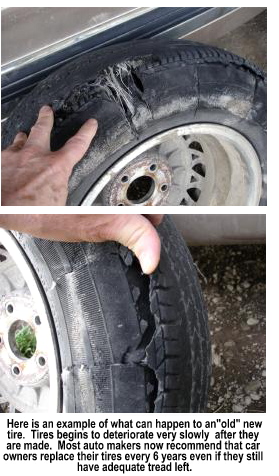
News
Behind the Headlines
Two-Cents Worth
Video of the Week
News Blurbs
Articles
Testimony
Bible Questions
Internet Articles (2015)
Internet Articles (2014)
Internet
Articles (2013)
Internet Articles (2012)
Internet Articles (2011)
Internet Articles (2010)
Internet Articles
(2009)
Internet Articles (2008)
Internet Articles (2007)
Internet Articles (2006)
Internet Articles (2005)
Internet Articles (2004)
Internet Articles (2003)
Internet Articles (2002)
Internet Articles (2001)


![]() ou
planned this year's family vacation for the better part of a year. As
V-day arrives, you do the "dime" test on your tires and decide
the tread is just a little too worn for a worry-free trip halfway across
the country to visit family members. You jump into the conversion van
and drive to the local tire shop for a set of brand new tires. Only, 500
miles into your trip, the tread on one of the tires separates, giving
the family a scare as you battle to keep your suddenly out-of-control
van from flipping over in the median.
ou
planned this year's family vacation for the better part of a year. As
V-day arrives, you do the "dime" test on your tires and decide
the tread is just a little too worn for a worry-free trip halfway across
the country to visit family members. You jump into the conversion van
and drive to the local tire shop for a set of brand new tires. Only, 500
miles into your trip, the tread on one of the tires separates, giving
the family a scare as you battle to keep your suddenly out-of-control
van from flipping over in the median.
 When
the family climbs out of the van to check the damage, everyone notes that
the tread had separated and peeled completely off one of those brand new
tires. The first thought that comes to your mind? Remembering last's years
headlines about defective tires made in China, you think, we got stuck
with some Chinese tires. Not so. You simply bought "old" new
tires. Tires have a "shelf life" of 3.5 years. Many times they
are stored for five or six years in a warehouse before they are sold.
According to advocates for tire safety—which include Ford, GM,
Chrysler, Toyota and Honda—tires past their "shelf-life"
lifespan should not be sold.
When
the family climbs out of the van to check the damage, everyone notes that
the tread had separated and peeled completely off one of those brand new
tires. The first thought that comes to your mind? Remembering last's years
headlines about defective tires made in China, you think, we got stuck
with some Chinese tires. Not so. You simply bought "old" new
tires. Tires have a "shelf life" of 3.5 years. Many times they
are stored for five or six years in a warehouse before they are sold.
According to advocates for tire safety—which include Ford, GM,
Chrysler, Toyota and Honda—tires past their "shelf-life"
lifespan should not be sold.
ABC-affiliate KGO-TV in San Francisco found one tire made in 1999 and two from 2000 at a Goodyear store during a local investigative report on retailers selling "old" new tires earlier this year. ABC-affiliate WRTV-TV found a 1999 and 2002 tire at an Indianapolis Walmart. The Orlando ABC affiliate found tires dated 1999 and 2000 at one of their local Walmart. (Walmart is now the nation's largest tire retailer.) ABC-News program "20/20" did an investigative report on "old" new tires and found nearly a dozen old tires being disposed of at three different Sears stores in a "manager's clearance sale." The three dozen tires ranged from 7 years old to one that was manufactured in 1996—making it 12 years old.
In 2005, Ford Motor Co. became the first US automaker to advise consumers that tires made in 1999 or earlier should be replaced even if the tread is not worn. "Tires degrade over time," the Ford warning noted, "even when they are not being used. It is recommended that tires generally be replaced after 6 years of nominal service. Heat caused by hot climates or frequent high loading conditions can accelerate the aging process." In another statement Ford spokesman Dan Jarvis made it clear that Ford believed tires aged—like people. "We always try to be driven by the facts," Jarvis said. "Once we have the facts, we make recommendations as we see fit. Tires are perishable items. They don't last forever."
In 2002—a year before anyone realized the danger of "old" new tires, 59-year old furniture salesman and Danville, California resident Jack Crane decided to let his two sons—Joe Crane, age 20 and Robert Crane, age 17—take his 1988 Ford Bronco to the beach. Joe was a good driver, and the car was in good repair. In fact, the one bad tire on the car had just been switched for the 14-year old original still-new spare tire. As the brothers headed up Interstate 5 for a San Francisco Bay beach weekend, the full tread spare blew, and with a loud ugly slapping sound muffled by the voices of the brothers, the Bronco flipped over into the median. Seventeen-year old Bobby sustained a fractured skull and began to hemorrhage. He died at the scene. The Crane's lawyer, Michael Danko, argued in the filing of his lawsuit that evidence exists that proves the tire industry has known about the risk of tire aging for a long time, but never warned the consumers of the danger.
If you've ever gotten a fantastic price on tires in the past and couldn't figure out what you did to deserve such a good deal, now you know. Prior to 2003 the dangers of old inventory tires were not known, but tire distributors urged dealers to rotate their inventories and sell old tires before they reached 6-years of age (suggesting that while the public was unaware of the dangers of "old" new tires,US tire manufacturers knew a danger of tread separation existed when new tires pass a certain milestone age. In the manuals that come with their vehicles since 2003, European and Japanese car manufacturers have warned consumers to replace tires that were older than six years regardless how much tread remained on the tires. Volkswagen's manual states: "WARNING—old tires can fail in use, causing loss of vehicle control and personal injury. Replace tires after 6 years regardless of tread wear."
Since 2003 Ford Motor Company has funded several studies on all facets of tire safety including how tires "age," and how old tires perform at different stages of tire life. The 6-year maximum tire life rule that has been adopted by almost every auto manufacturer in the world is based not on speculation, but on solid scientific research. Tire manufacturers, who feel they are the industry "experts," disagree. However, since they are driven by the economic need to generate a sufficient inventory of tires in every feasible size for every conceivable demand whenever and wherever it appears, clearly this requires an adequate stockpile of tires. The tire industry, without federal regulations mandating it, will not voluntarily destroy stockpiles of obsolete tires, or even for that matter, acknowledge that they might be obsolete.
If you were a resident of the European Union, you can kneel down and look at your tires and see the date they were manufactured. In Europe, the manufacture code is at the end of the long line of numbers that identify the tire size. You will see a series of numbers that will look something like this: P195/60R15 87Q 345. What do the numbers mean? "P" stands for "passenger vehicle. "195" is the width of the tire in millimeters. "60" is the aspect ratio (the ratio of the height of the tire to the width). "R" means it is a radial tire. "15" represents the wheel diameter in inches. "87" is the load index and "Q" is the speed rating of the tire.
Prior to 2000 the tire manufacture date was a three digit code. Beginning in 2000 it became a four digit date. Therefore, "345" tells you the tire was made in the 34th week of 1995. If you just bought those tires it means you purchased "new" tires that were actually 18 years old when you put them on your vehicle. The tragedy is that when you go to your local Firestone™, Dunlop™, Bridgestone™, Pep Boys, Sears—or anywhere tires are sold in your town—you pick the brand and style of tire that is going on your car, but you don't get to physically inspect the tires that are going on your car to see when the tire was made. Its not likely the salesman who sold you your new tires, or even the tire jockey putting those tires on your car has the answer to that question either since, in the United States, every tire manufacturer puts the manufacture date on the inside of the tire where it can't be seen. If you want to know when the tires on your vehicle were manufactured, you will have to lay down and look under your car at the reverse side of the tire.
In Europe, all of the numbers on the tire are visible to the consumer when they bend down and look the sidewall of the tires on their vehicles. In the United States, the tire lobby has done a good job of bribing Congressmen and Senators with campaign contributions. While most of the laws politicians pass for the transnational industrialists, barons of business and the merchant princes merely cost you money, in this case, the "innocent" political quid pro quo of allowing tire manufacturers to bury the tire manufacture date code on the backside of the tire where you can't see it can cost you or a loved one their life. Think about that the next time the media tells you that you should vote for a political candidate because he or she raised $50 million dollars to finance their campaign. We need the tire manufacture code on the front side of the tire with the other Tire Identification Codes, and we need political contributions (i.e., legal bribes) outlawed.
The National Highway Traffic Safety Administration has been petitioned by tire safety advocates for two things. First, safety advocates want an easy-to-read tire age label on the front, not the back, of the tire where consumers can be reminded that their tires need to be replaced. Second, tire safety advocates want a law enacted that will force tire manufacturers to recall out-of-date tires and destroy them. Sadly, NHTSA spokesperson Rae Tyson said that, at this time, the NHTSA is weighing the petition to put expiration dates on the front of the tires. But, "...the agency is not ready to issue any kind of consumer advisory, but that it does not prevent automakers or tire companies from issuing their own warnings if they have research suggesting a safety issue."
Clearly, the lobbyists for the tire industry and the Rubber Manufacturers' Association are pressuring both the NHTSA and key members of Congress not to mandate expiration dates for tires, nor move the date from the backside tire wall to the outside where it is visible to the consumer. In response to requests for added safety regulations on tires, Congress has given the NHTSA a virtually impossible task: devising a test that will accurately simulate tire aging. Congress asked for the test after the Firestone recall about a decade ago in order to create legislation that will require tire retailers to dispose of date-expired tires. Will that legislation ever see the light of day? Probably not as long as politicans are allowed to accept legal bribes in the form of political contributions.

Copyright © 2009 Jon Christian Ryter.
All rights reserved.

